State Council sets up investigation team to carry out truthful review of Henan flood disaster that killed 302

Weihui, Henan Photo: VCG
The State Council, China's cabinet, on Monday set up a task force to investigate the torrential rains and floods that killed 302 and caused massive losses in Central China's Henan Province. The team will carry out a scientific, truthful and comprehensive investigation and review of the disaster response to summarize experiences for the future, give disaster reduction advice and punish any potential dereliction of duty.Experts say a credible investigation is crucial in responding to people's questions and is an important way to rebuild the local governments' credibility.
As the result of one of the most deadly accidents caused by natural disaster, the death toll rocketed to 302 as of Monday since downpours and floods hit Henan in mid-July, and 50 are still missing, the provincial authority said at a Monday press conference.
Provincial capital Zhengzhou suffered the highest casualties of 292, with 47 missing. Among them, 189 died due to floods and debris, 54 due to collapsed houses, and 39 due to underground inundations.
Among the deaths, the inundation of a subway train that killed 14 and the Beijing-Guangzhou Tunnel inundation that killed six received the most attention.
After the disaster, some asked whether sufficient attention had been paid to the rainstorm forecasts, and whether the disaster response could have been better handled and some deaths could have been avoided.
Henan governor Wang Kai said at the press conference on Monday that the floods were a major test and exposed shortfalls in governance, vowing to learn a lesson from the disaster and strengthen flood control and urban management. Wang expressed deep condolences to the victims of the disaster, and to the workers who gave their lives while carrying out flood control and rescue.
Credible answers needed
The rainfall disaster in Henan is believed to be one of the most deadly incidents caused by a natural disaster in recent years, after the capsized cruise ship Eastern Star sank in the Yangtze River on June 1, 2015. The cruise ship accident resulted from severe convective weather, leading to 396 deaths and 46 missing.
Investigation reports are expected to cover the entire process of the disaster response, including pre-warning, emergency planning and coping measures, and to cover deaths in underground spaces, the issue of greatest concern to the public.
On July 20, water inundated Line 5 of the Zhengzhou Metro, one of the busiest subway lines in the city, forcing the train to stop between Shakou Road Station and Haitansi Station. More than 500 passengers on board were trapped in neck-deep water for nearly four hours. Fourteen people died after torrential rains flooded the subway.
The tragedy drew reflections nationwide that decisive measures and precautions must be taken to avoid similar misfortune
Setting up the task force reflects the utmost importance the State Council attaches to such a major disaster causing heavy casualties and property losses, a professor surnamed Zhang from Peking University told the Global Times on Monday. The unexpected disaster reminds us that we should not underestimate natural disasters that we have rarely experienced, and the relevant drills as well as quick responses can be never absent in order to minimize casualties and damage, said Zhang.
The flood will lead to a major reassessment and approval of the entire emergency management and response regime in Zhengzhou, but it will take time, considering the current resurgence of COVID-19 in the city, which is challenging the city's governance resources, Zhang noted.
Ma Jun, director of the Beijing-based Institute of Public and Environmental Affairs, told the Global Times that the Henan floods exposed loopholes in both administrative management as well as construction and maintenance of flood control.
On July 20, the Zhengzhou meteorological department issued a total of 10 red alerts for rainstorms. Guidelines for red alert, the highest warning signal, require the suspension of rallies, classes and businesses (except for special industries), and all emergency responses are required. But the red alerts failed to raise the local governments' alarm in Henan.
Some Zhengzhou residents reached by the Global Times said that they did not receive notices of school or business suspensions until July 21, and many people continued to commute as usual.
Sending a task force is a strong signal from the central government that it is probing misconduct in this Zhengzhou disaster, and tells the public that the local governments cannot remain blind to the questions raised.
Traditional ways of mourning the dead and honoring the heroes of disaster relief in past decades are not enough to end public doubts, Gao Jianguo, an expert from China Association for Disaster Prevention, told the Global Times on Monday.
"Restoring the credibility of the local governments by giving transparent and responsible feedback and reflecting on the whole process in the post-disaster period is crucial," Gao noted.
Reflections for future
Cities other than Zhengzhou also suffered casualties amid urban waterlogging. With some rural areas still ramping up water drainage and victim resettlement efforts, statistics on losses could be further updated.
Xinxiang city to the north of Zhengzhou on the other bank of the Yellow River, where some villages are still flooded, registered seven deaths and three missing. Two people died in Pingdingshan city and one died in Luohe city.
Some 14.5 million people in 150 counties in Henan have been affected by the disaster. Resident evacuations peaked at 1.47 million while some returned home later. As of Monday, 933,800 people were relocated.
About 89,000 houses collapsed and 1.09 million hectares of farmland were impacted, of which 253 hectares suffered complete devastation.
Direct economic losses from the downpours, floods and inundation totaled 114.3 billion yuan ($17.7 billion), according to press conference.
Historic rainstorms started to hit northern parts of Henan Province from July 16, setting new daily and hourly precipitation records. Weather forecast organs said that rainfall in Zhengzhou on July 20 were close to the city's average annual precipitation.
Analysts said that Henan, which has mostly suffered drought in the past, does not have rich experience in dealing with sudden floods and severe downpours as some southern China cities do, but netizens' doubts have prompted the government to come up with an answer.
"Were warnings fully delivered to residents? Was the transportation system suspended in time? Are emergency plans for the underground system well designed? Did the 'sponge city' with its huge investment maximize its capacity? The Zhengzhou government may have to give the answers," said Gao, stressing that these reflections are essential for future improvements.
Experts also called for reflection on intra- and inter-coordination between different departments. "Even though the government had made a preparedness plan, some local officials failed to make decisive decisions when people were in danger of dying," Ma Jun said, referring to the Zhengzhou metro tragedy, where floods broke the water retention wall and rushed into the subway station, trapping more than 500 passengers and killing 14 at the end.
Experts have also advised carrying out reevaluation and redesign of some urban planning and infrastructure in Zhengzhou, such as the Beijing-Guangzhou Tunnel, which can be equipped with two-way emergency lanes. When water is found in the tunnel, pumping operations should be arranged immediately and the tunnel entrance should be closed according to the crisis level, Wan Yanhua, a professor of urban planning at Huazhong University of Science and Technology, told the Global Times on Monday.
Flood control standards should also be improved in key areas such as hospitals, after at least two large hospitals in Zhengzhou suffered heavy losses in the disaster, Wan noted.
The investigation into the unprecedented natural disaster-induced incident has to be factual, systematic and comprehensive, and respond in detail to the key questions raised by the public, Wang Hongwei, a professor at the Renmin University of China's School of Public Administration and Policy, told the Global Times on Monday.

